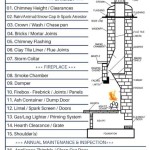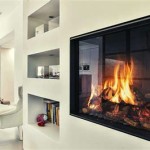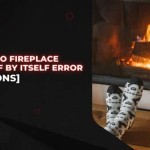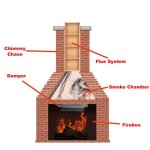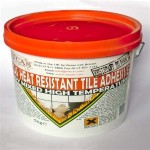Thin Brick Fireplace: A Comprehensive Guide
The thin brick fireplace has emerged as a popular choice for homeowners seeking to add a touch of classic elegance and rustic charm to their living spaces without the weight and space demands of traditional brick. This construction method utilizes thin slices of brick, adhered to a substrate, to create the visual appeal of a full brick fireplace, offering a range of aesthetic and practical benefits. This article provides a comprehensive overview of thin brick fireplaces, including their advantages, installation considerations, design options, and maintenance requirements.
Advantages of Choosing a Thin Brick Fireplace
Thin brick offers several key advantages over traditional brick, making it a compelling option for fireplace construction and renovation. These benefits span cost, installation ease, design versatility, and structural considerations.
Reduced Weight and Structural Load: Traditional brick is heavy, requiring substantial structural support, particularly in upper-story installations. Thin brick, being significantly lighter, minimizes the load on the building's structure. This is especially advantageous in existing homes where reinforcing the foundation or framing might be costly or impractical. The reduced weight also simplifies handling and transportation during the installation process.
Simplified Installation: Installing traditional brick involves time-consuming mortar work and precise bricklaying. Thin brick, on the other hand, is typically adhered to a substrate using thin-set mortar, a much simpler and faster process. This reduces labor costs and allows for a quicker project completion time. Moreover, thin brick can be cut and shaped more easily than full brick, facilitating intricate designs and accommodating irregular surfaces.
Cost-Effectiveness: While the cost of the thin brick itself may be comparable to that of traditional brick, the overall project cost is often lower due to reduced labor, lower transportation expenses (due to the lighter weight), and less extensive structural support requirements. This makes thin brick a budget-friendly option for homeowners looking to achieve the look of a brick fireplace without incurring excessive expenses.
Increased Design Versatility: Thin brick is available in a wide range of colors, textures, and sizes, providing immense design flexibility. It can be used to replicate the look of antique, reclaimed, or contemporary brick, catering to diverse architectural styles and personal preferences. Furthermore, thin brick can be installed in various patterns, such as herringbone, running bond, or stacked bond, allowing for customized and visually appealing designs.
Space Saving: In smaller homes or rooms, the reduced thickness of thin brick can be a significant advantage. It allows homeowners to achieve the desired brick aesthetic without sacrificing valuable floor space. This is particularly relevant in urban dwellings or apartments where space is at a premium.
Installation Considerations for Thin Brick Fireplaces
Proper installation is critical to ensuring the longevity, safety, and aesthetic appeal of a thin brick fireplace. Several key considerations must be addressed during the installation process, including substrate preparation, mortar selection, and brick application techniques.
Substrate Preparation: The substrate, which is the surface to which the thin brick is adhered, must be clean, level, and structurally sound. Common substrates include concrete board, cement board, or prepared drywall. The surface should be free of dust, dirt, grease, and any loose particles. It is crucial to prime the substrate with a suitable primer to enhance adhesion and prevent moisture absorption. In cases where drywall is used, it is essential to ensure that it is properly supported and rated for the intended application, considering the heat generated by the fireplace.
Mortar Selection: The choice of mortar is critical for achieving a strong and durable bond between the thin brick and the substrate. A high-quality thin-set mortar specifically designed for brick veneer is recommended. The mortar should be mixed according to the manufacturer's instructions and applied evenly to the back of the thin brick using a notched trowel. It is important to select a mortar that is appropriate for both interior and exterior applications, especially if the fireplace is located near an exterior wall or in a humid environment.
Brick Application Techniques: The thin brick should be applied to the substrate with firm pressure, ensuring full contact with the mortar. Spacers can be used to maintain consistent joint widths, creating a professional and uniform appearance. It is essential to regularly check the alignment and level of the bricks during installation. Excess mortar should be removed promptly to prevent staining. The pattern of brick placement should be carefully planned to achieve the desired aesthetic. Various patterns like running bond (staggered), stack bond (aligned), herringbone, or custom designs can be employed based on the homeowner's preference.
Firebox Considerations: The firebox, the area where the fire burns, requires special attention. It must be constructed of fire-resistant materials that can withstand high temperatures. Firebrick, a specialized type of brick designed for high-heat applications, is typically used for lining the firebox. It's essential to consult local building codes and regulations regarding fireplace construction and fire safety to ensure compliance.
Venting and Clearances: Proper venting is crucial for the safe and efficient operation of a fireplace. The flue, which carries smoke and combustion gases out of the house, must be appropriately sized and installed according to building codes. Adequate clearances around the fireplace are also necessary to prevent combustible materials from overheating. These clearances are specified in building codes and vary depending on the type of fireplace and the surrounding materials.
Design Options and Aesthetic Considerations
The versatility of thin brick allows for a wide range of design options, enabling homeowners to create fireplaces that complement their individual styles and enhance the overall aesthetic of their homes. Factors such as brick color, texture, pattern, and accent features can be customized to achieve the desired look.
Brick Color and Texture: Thin brick is available in a virtually limitless array of colors, ranging from traditional reds and browns to contemporary grays and whites. The texture can also vary significantly, from smooth and uniform to rough and tumbled, mimicking the look of aged or reclaimed brick. The choice of color and texture should be carefully considered in relation to the existing décor and architectural style of the room. Lighter colors can create a brighter and more spacious feel, while darker colors can add warmth and depth.
Brick Patterns: The pattern in which the thin brick is installed can dramatically impact the overall appearance of the fireplace. The running bond pattern, with its staggered arrangement, is a classic and versatile choice. The stack bond pattern, with its aligned bricks, offers a more modern and minimalist look. The herringbone pattern, with its angled bricks, adds a touch of sophistication and visual interest. Homeowners can also create custom patterns to express their unique style.
Accent Features: Various accent features can be incorporated into the thin brick fireplace design to enhance its visual appeal. These features can include mantels, hearths, surrounds, and decorative inlays. Mantels can be made of wood, stone, or metal, and can range from simple and understated to ornate and elaborate. Hearths, which are the horizontal surfaces at the base of the fireplace, can be made of brick, stone, or tile. Surrounds, which frame the fireplace opening, can be made of wood, metal, or other materials. Decorative inlays, such as mosaics or metal accents, can add a touch of personality and visual interest.
Style Considerations: The design of the thin brick fireplace should complement the overall architectural style of the home. In traditional homes, a classic red brick fireplace with a wood mantel and a brick hearth can create a warm and inviting atmosphere. In modern homes, a sleek gray brick fireplace with a metal surround and a minimalist design can add a touch of contemporary elegance. In rustic homes, a reclaimed brick fireplace with a stone mantel and a rough-hewn hearth can create a cozy and charming ambiance.
Combining with other materials: Thin brick can be effectively combined with other materials for visual effect. Stone accents, wood trim, and even metal elements can be integrated into the design to create a customized and visually appealing feature in any room. The juxtaposition of different textures and materials can add depth and character to the fireplace.
By carefully considering these design options and aesthetic considerations, homeowners can create thin brick fireplaces that are not only functional but also visually stunning focal points in their homes.
The proper construction ensures a long-lasting and safe fireplace that will be an attractive addition to any home for years to come.
.png?strip=all)
Blog Contact Cherokee Brick

How To Diy A Fireplace Surround Using Thin Bricks The Sommer Home

Thin Brick Henry

Grey Is The New Red In Thin Brick Veneer Stone Farm

Thin Brick Veneer Burnstein

Think Thin Brick South Alabama Company

How To Install Thin Brick Veneers On Your Fireplace

Thin Brick S From Pine Hall Are True Only Thinner

Handmade Thin Brick Galleries

Thin Brick Wood Stove Surround Looks Great Feels Toasty
Related Posts

